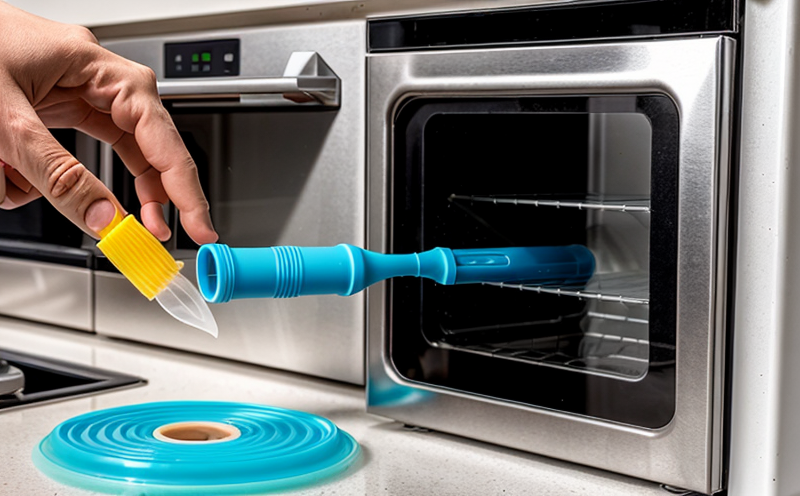ASTM D7605 Color Stability Testing of Household Plastics
The testing of household plastics under ASTM D7605 is a critical process in ensuring that the products meet consumer expectations and regulatory requirements. This standard specifically addresses color stability, which refers to the resistance of plastic materials to discoloration when exposed to sunlight, heat, or other environmental factors over time. Color stability is crucial for maintaining brand identity and product functionality.
The test procedure involves exposing samples of household plastics to a combination of ultraviolet light (UV) and heat in an accelerated aging chamber. The purpose is to simulate the effects of long-term outdoor exposure that a plastic product might experience during its lifetime. This includes changes in color, texture, and mechanical properties due to photodegradation or thermal degradation.
The testing process typically follows these steps:
- Sample preparation: Ensuring uniformity across all samples is vital for accurate results. Samples are cut into standard sizes and shapes as per ASTM D7605 guidelines.
- Pre-aging: Some samples undergo a pre-aging step to simulate real-world conditions before the main test.
- Exposure: Samples are exposed to UV light and heat in an accelerated aging chamber. The duration of exposure depends on the desired level of degradation simulation.
- Post-exposure analysis: After exposure, the samples are visually inspected for changes in color and texture. Additional tests may include mechanical property assessments to evaluate any loss in strength or flexibility.
The results from ASTM D7605 testing provide valuable data that can influence various aspects of product development, including formulation adjustments, material selection, and design improvements. By understanding how different plastics perform under these conditions, manufacturers can enhance the durability and appearance of their products, ultimately leading to better consumer satisfaction.
| Test Parameter | Description |
|---|---|
| UV Exposure Time | The duration for which samples are exposed to UV light. This varies based on the desired outcome and can range from days to weeks. |
| Temperature Range | The temperature at which samples are kept during exposure, typically between 60°C and 85°C. |
| Specimen Size | The dimensions of the plastic specimens used in testing. ASTM D7605 specifies standard sizes for different types of plastics. |
| Color Change Measurement | A visual assessment or more precise measurement using a colorimeter to quantify changes in color. |
The importance of this testing cannot be overstated, especially in the context of household products. Consumers expect their appliances and utensils to remain attractive and functional for extended periods without significant deterioration. ASTM D7605 helps manufacturers meet these expectations by providing a standardized method for evaluating color stability.
Quality and Reliability Assurance
- Consistent Testing Conditions: Ensures that all samples are exposed to the same environmental conditions, leading to reliable data.
- Material Homogeneity: Guarantees that each sample is representative of the entire batch, minimizing variability in results.
- Regular Calibration: Prevents errors due to instrument drift or malfunction by ensuring all equipment is accurate and up-to-date.
- Data Analysis: Utilizes statistical methods to interpret test results accurately, providing actionable insights for product improvement.
The rigorous nature of ASTM D7605 ensures that the testing process maintains high standards of accuracy and precision. This leads to products that are not only aesthetically pleasing but also structurally sound, contributing significantly to overall customer satisfaction and trust in the brand.
Customer Impact and Satisfaction
ASTM D7605 testing plays a pivotal role in enhancing the quality of household plastics. By ensuring that products meet stringent color stability standards, manufacturers can offer consumers durable and visually appealing items. This is particularly important for high-contact areas like kitchen utensils or bathroom fixtures, where aesthetics and functionality are paramount.
The test results help companies avoid potential issues such as premature discoloration or loss of strength, which could lead to product recalls or customer dissatisfaction. Compliance with ASTM D7605 also offers a competitive edge in the market, as it demonstrates a commitment to quality and consumer safety.
Use Cases and Application Examples
- Kitchen Appliances: Ensuring that plastic components of appliances like blenders or food processors maintain their color over time.
- Bathroom Fixtures: Guaranteeing the longevity and appearance of items such as shower heads or faucets.
- Cookware Utensils: Maintaining the vibrant colors and durability of spatulas, tongs, or other cooking tools.
- Toys & Children's Products: Ensuring that toys are safe for prolonged use without losing their appeal or potentially harmful chemical leaching due to degradation.
| Use Case | Description |
|---|---|
| Kitchen Appliances | Testing ensures that plastic parts remain attractive and functional for extended periods, enhancing user satisfaction. |
| Bathroom Fixtures | Aesthetic and functional integrity of fixtures is maintained over time, reducing the need for frequent replacements. |
| Cookware Utensils | Color stability ensures that utensils retain their appearance while also maintaining structural integrity during use. |
| Toys & Children's Products | Safety and durability are paramount, ensuring toys remain safe and appealing for children to play with over extended periods. |
The application of ASTM D7605 is broad across various industries. Its relevance extends beyond household products to industrial applications where color stability can affect performance or safety. By adhering to this standard, manufacturers can ensure their products meet the highest quality standards and provide long-lasting value to consumers.





